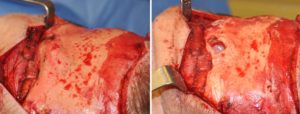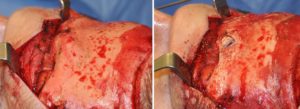Brow bone reduction alters the amount of forward projection of the lower third of the forehead. When it is a craniofacial bone reduction procedure it is unique because of the underlying frontal sinus. This is true for at least the inner half of the brow bones whose shape is controlled by the size of the frontal sinus. (the outer half of the brow bones is solid bone)
As a result of this anatomy performing brow bone reduction by burring alone has its limitations. Beyond a few millimeters of bone removal the frontal sinus air space is encountered. This is why more significant reductions require a bone flap technique where the outer table bone of the frontal sinus is removed, reshaped and then replaced.


This modified brow bone reduction technique is a good method for some male patients who want the amount of projection reduced but still want to have some remaining brow bone projection. It can also be useful in some select transgender patients whose brow bone projections are more modest in size.
Dr. Barry Eppley
Indianapolis, Indiana




